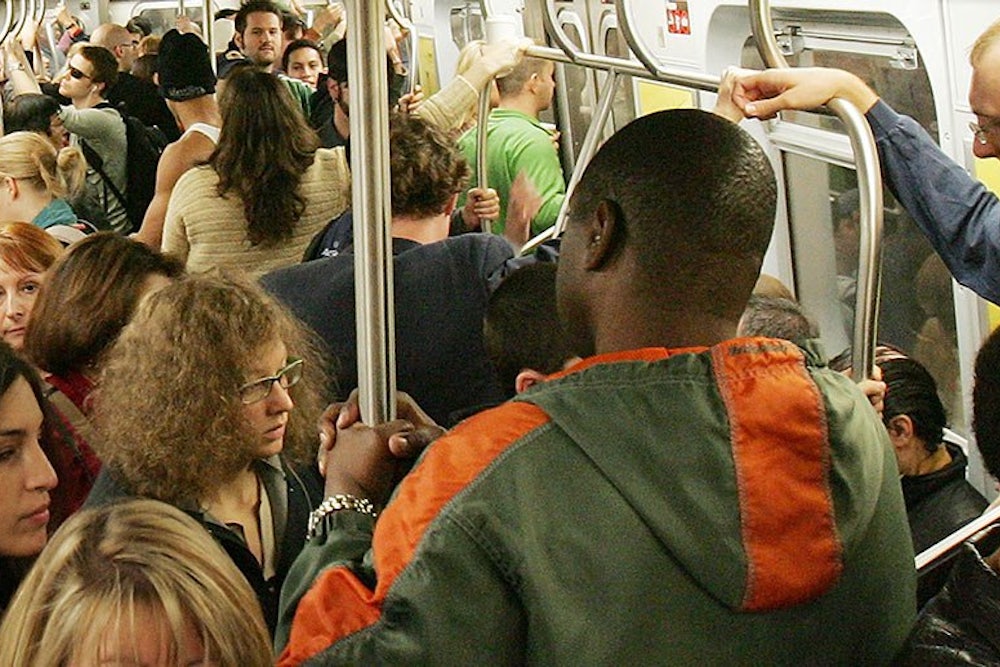I was riding an N train, heading uptown in Manhattan, when I learned about a new study that catalogued the wonderworld of microflora accompanying me in the New York subway system. I read about them on my phone, which I typically keep in my pants pocket snug beside my handkerchief and which I also stick periodically against my face; in my other bare hand, I clung to one of the runner poles that often serve as a commuter’s oh-shit handles. That was the less-than-sanitary position I was in when I saw this quote to the New York Times, from a geneticist named Dr. Christopher E. Mason, the study's lead author: "People don't look at a subway pole and think, 'It's teeming with life.' After this study, they may."
I'd been holding the subway pole for the better part of half an hour when I learned that researchers who scoured public transit in New York found "hundreds of species" of bacteria on the trains, along with a smidge of bubonic plague and anthrax, inert. Only 2 percent of the 15,000 types of DNA swabbed out of the subway's bowels were human, raising the obvious and unsettling question of who the other 49 of every 50 riders are. (Vermin, cheeses and an astonishingly large stock of unknowns, it turns out.) When the train stopped, I got off and walked over to a kiosk in the Union Square farmer's market, where I helped myself to a sample of cranberry horseradish, scooping the partially frozen mash onto a saltine. Who knows what was reproducing asexually on my hand as I did that? Who knows what had been on the hands of the last random person to reach into that bag of crackers? I snacked, went to my office, and washed my hands in very hot water. (Only later did a colleague inform me that scalding germs is pointless.)
The Times piece was, in one fashion, much like other reports on the study: It was meant to straight freak us out. BuzzFeed used the words "terrifying" and "microbes" in the same headline; New York went with "disgusting." The Times, though, offered a correction that somehow made the news more nauseating: "An earlier version of this article misstated the ridership of New York’s subway system. It is 5.5 million riders per average weekday, not average week." How many millions of trips do people take on the subway each week? Five, or more like 35? Who even knows? Humans teem in the trains in numbers that are themselves almost bacterially abstract.
This is just the ocean we swim in without even noticing we're wet. New Yorkers have never deluded ourselves that they're anything but cells sluicing through a superorganism, bumping against and through our fellow citizens' inner worlds. We drink each other's sneezes, eat one another's coughs, and breathe one another's airborne dander. The subway has always epitomized this human barnyard, blurring the lines between how we feel and how we live. We're not just sleepy; we're passed and hunched over a guitar case. We're not just hungry; we're mumbling through godblessyous and pleasesirs passing a cup of scanty change around the car. It doesn't require a 17-month study with swabs to find how much stray life is thriving on these trains, but apparently it doesn’t hurt.
New Yorkers have recoiled at this bit of news before, in short order, shrugging it off. The Metropolitan Transportation Authority has bristled at the implication that it's running an electrified septic tank. "As the study clearly indicates, microbes were found at levels that pose absolutely no danger to human life and health," Kevin Ortiz, an MTA spokesman, told me in an email. "The subway environment is no different than the environment above ground." People in this city enjoy some of the finest drinking water in the world, and yet some regard anything other than bottled or multiply ionized as if it had just fracked a West Virginia gas well. They stand in Whole Foods check-out lines 10 deep and six wide during flu season. They control positively everything they can about their lived environment aside from the other 98 percent the city imposes on them. To learn the subway is a trove of Darwinian overabundance only puts a vague quantitative value on what we already knew: underground (as perhaps above), it's all sewer here.
No one will avoid the subway after reading how scuzzy it is. Maybe they'll remember to use their sleeve to hold the handrail on the stairs; maybe they'll be more conscientious about using Purell before wiping their eyes. Maybe not. Nor should they; killing everything that makes you tougher is no way to live in the city. The subways might as well be a Lower East Side restaurant: too clean and you can't trust it—'cause who's even been inside? There’s no better assurance of hygienic safety, after all, than to see 5.5 million people use the subway on any given day and to survive the experience in very similar numbers.
